
They’ve never ever done anything wrong,” one woman says of her three XL bully dogs. “We’ve owned bull breeds for 10 years and they’ve never put a foot wrong, we’ve never had altercations in public, we have had nothing but a positive experience.”
Heather Halls and her husband Chris have spent the past few weeks in disbelief after Rishi Sunak announced in September that American XL bully dogs would be banned in the UK following a spate of high-profile attacks and fatalities.
Not only do three of their family dogs fall into this category, but Chris is a professional dog trainer specialising in bulldog breeds, meaning that their entire livelihood is now at stake. They also compete in the Protection Sports Association, by which two of their XL bullies have been awarded titles.
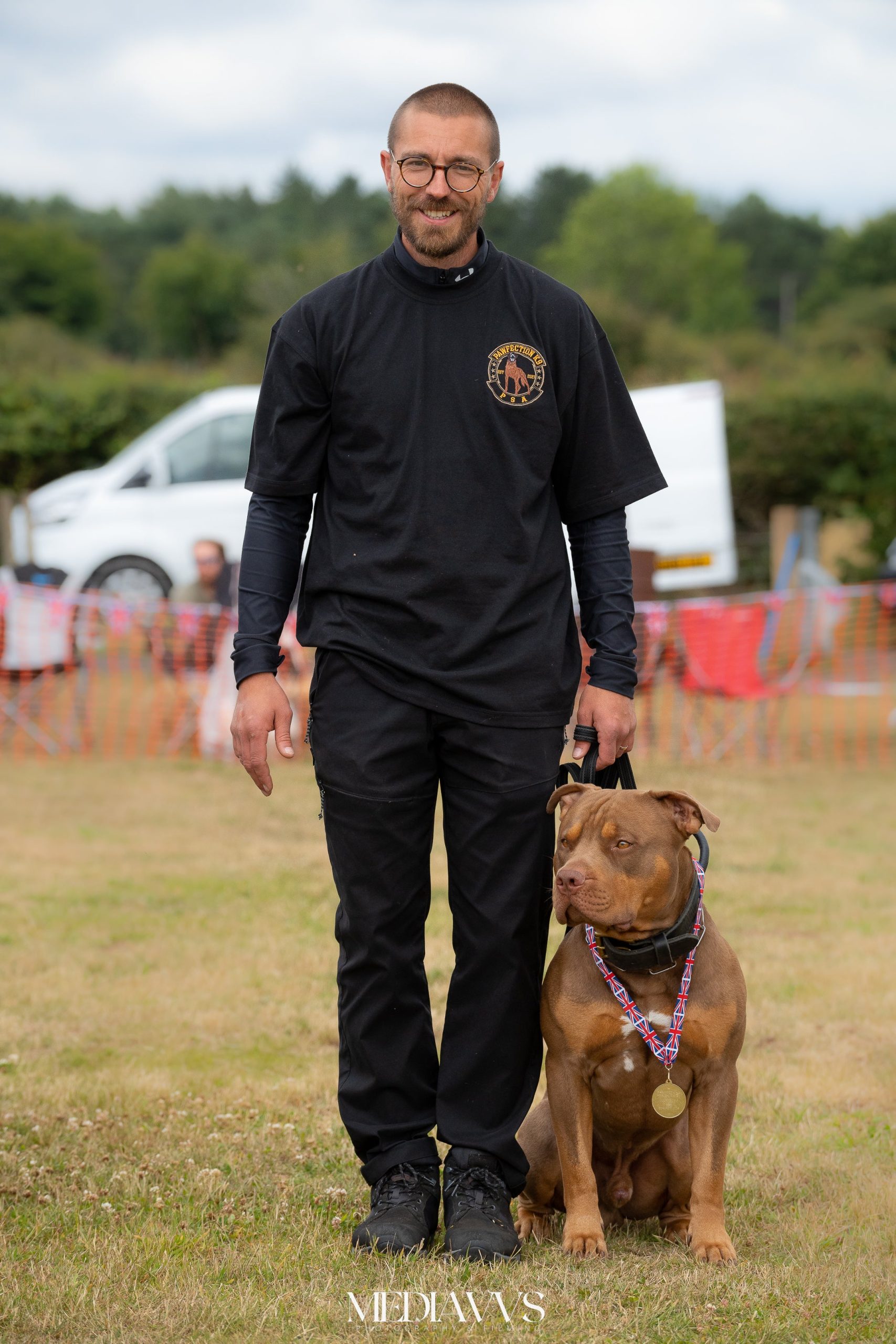
“Essentially, our whole world and what we’ve worked towards in the last few years is about to get flipped on its head,” says Heather.
The couple have now joined forces with other XL bully owners to launch an official campaign to challenge the government’s stance, with more than £86,000 raised in a matter of days to support legal action.
Campaigners from Don’t Ban Me – Licence Me are asking the Department for the Environment, Food and Rural Affairs (Defra) to rethink their plans and are fundraising for a judicial review.
Poor breeding to blame for XL bullies attacking people, says dog trainer
With the support of their barrister John Cooper KC, they sent a warning of their intention to launch legal action to the environment secretary Therese Coffey last Thursday, as they hope to scrap the planned ban in favour of tightened laws around breeding and ownership.
Under new legislation, it will be illegal to sell, breed or abandon an XL bully-type dog from 31 December, while it will be an offence to own one from 1 February 2024 unless it is registered to the government’s database, the Index of Exempted Dogs.

Once their animal is registered, owners will have to abide by strict regulations, which include keeping their dogs muzzled and on a lead at all times in public, having them neutered and microchipped, and having to carry a certificate of exemption at all times to show police officers or council dog wardens.
Alongside descriptions of head size and physical features, the government has defined an American XL bully as an adult male from 20in in height, or an adult female from 19in. However, given that XL bullies have never been defined as an official breed, this has confused owners of cross-breeds such as mastiffs and mongrels.
The decision to ban the breed came after deaths relating to XL bully attacks, including those of 10-year-old Jack Lis and 17-month-old Bella-Rae Birch. Two people were injured in recent days in Mansfield by a suspected XL bully, while one report holds the breed responsible for nearly 50 per cent of all dog attacks in the UK.
Charities with the banned breed in their care will now receive £100 compensation for euthanising an XL bully, while owners will get £200 compensation if a vet euthanises their dog.

Speaking to The Independent, Sophie Coulthard, an organiser of the campaign group, says: “The problem with this knee-jerk reaction is that it won’t stop dog attacks. We need to focus on licensing and educating owners, with compulsory training and tougher punishments to prevent people from impulse-buying dogs.”
Sophie has owned her XL bully, Billy, for the last year, and has developed a following on TikTok by posting educational videos of his training as well as details of the proposed ban.
“One thing we’ve found is that people are really misinformed on the full impact of the ban,” she says. “What the government is asking me to do is look at their guidelines and commit him to a life on the muzzle, not go on holidays with him, have him muzzled in the car.
“There’d be no more playing with a toy in the park, anyone in social housing could lose their housing or their dog, you can no longer hire private fields to take dogs off the lead. It is really reducing the quality of life for these dogs.”
The group is arguing for the UK to take a similar approach to Canada’s Calgary model, an educational, licensing and stronger enforcement programme that has successfully reduced the number of dog bites by 70 per cent.

“I understand there’s been attacks, and I fully sympathise with anyone who has been a victim, because it’s horrific,” Heather says. “Dog ownership is a complete and utter mess, and people got these dogs in lockdown and haven’t socialised them or trained them. My son was bitten by a dachshund that shot out of a front door, so it’s not just XL bullies.
“Licensing is the right way forward. It’s proven to work in other countries and you can’t ignore the evidence that it works.”
Since the announcement, her five-year-old son panics each time he hears a siren, out of fear that police officers will arrive to take his dogs away. “Our dogs are our family pets,” says Heather. “I’ll do anything to keep my dogs safe. I will fight with my last breath.”
Bachelor Party Takes Unexpected Turn When They Hear Dog Barking In The Mud, Leading to an Unforgettable Rescue Mission.
Bachelor parties are a fun way to celebrate the ending of singlehood and the beginning of married life. Some people go absolutely wild in Vegas, some enjoy a quiet celebration with just a few buddies – there are a plethora of ways to have that last ‘huzzah’. Mitch White planned to have a relaxing canoe trip with his closest buddies. The groom-to-be had no idea that this trip would turn into a rescue mission for an elderly dog stuck in the mud. That’s a bachelor party he surely won’t forget.

Image credits: Carver County Sheriff’s Office
One lovely day, Mitch, a young groom-to-be, gathered his closest friends and set out on a canoe trip to celebrate his upcoming marriage. This bachelor party was supposed to be all about nature and bonding. And is there a better way to bond than rescuing a pup together?
Just after the group had lunch and moved on with their journey, Mitch’s nephew, Gaylen Fraenkel, heard a sad barking. They hadn’t encountered anyone, so it was highly unlikely it was some camper’s dog. The young man decided to turn the canoe around to make sure everything was okay. And good thing he did – a desperate dog was stuck in thick mud and using his last bits of strength to call for help.
Upon closer inspection, they saw that the poor fella was an elderly Saint Bernard. He was very thin and exhausted with a nasty tick attached to his eye. The rest of the group turned their canoes around and jumped in to help. The mud was so deep and thick, everyone sunk up to their knees. But they were relentless in their attempt to rescue the dog, using oars as shovels to dig him out.
Mitch White was out on his bachelor party trip with his closest friends. The guys were canoeing when they heard barking

Image credits: WCCO – CBS Minnesota
When they approached the shore they saw a dog asking for help, completely stuck in the mud

Image credits: WCCO – CBS Minnesota
The guys quickly jumped out and started digging him out, using oars as shovels

Image credits: WCCO – CBS Minnesota
To keep the pooch comfortable, they offered him water, of which he drank half a gallon before stopping. The kind guys shared their lunch with him, giving him some lunch meat and summer sausages. This quick snack was supposed to give him an energy boost to get up. The bachelors named him Wilson and called out his new name in an attempt to get him up, but he was too tired, even after the delicious summer sausages.
The group didn’t want to approach Wilson too closely as they didn’t see any collar and weren’t sure if he was friendly. That’s a good practice when dealing with a dog you don’t know.
Alex, one of Mitch’s friends, decided it was time to call for help and dialed up 911. He explained the situation and they dispatched the Carver Fire Department, who came to Wilson’s aid in 20 minutes. They brought a harness that they were able to get under his chest and the fire department men, together with two of Mitch’s friends, pulled Wilson out of his muddy prison. Hurray!
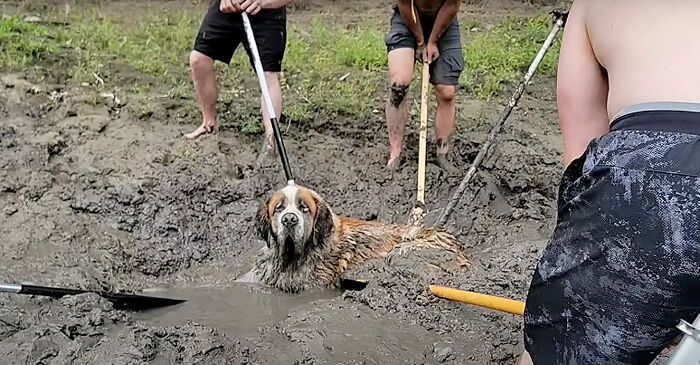
Image credits: WCCO – CBS Minnesota
Thanks to the kindness of the bachelors and help from the local fire department, the adorable pooch was rescued
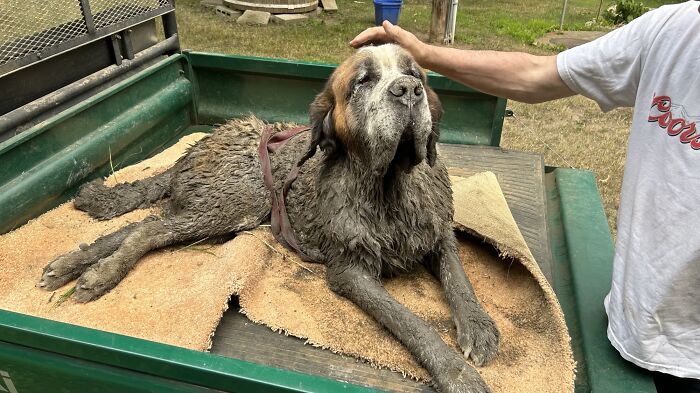
Image credits: Carver County Sheriff’s Office
After a successful rescue mission, Wilson was in for another pleasant surprise. Five minutes after he was pulled out of the mud, his owner showed up. He was surprised to see his four-legged pal all covered in mud. “Ed! What are you doing down there in the mud?!” he exclaimed at the sight of his dog. That’s how Mitch and his friends found out they’d been calling Ed the wrong name. Although he does look like a Wilson to me.
A couple of days ago, Mitch got a pleasant surprise when a friend of the owners reached out to him. He wanted to let Ed’s saviors know that he was doing much better, recovering nicely and was already moving around on his own. I bet his owners won’t let him out of their sight now.
Ed, a lovely senior Saint Bernard, was reunited with his owner and is feeling much better
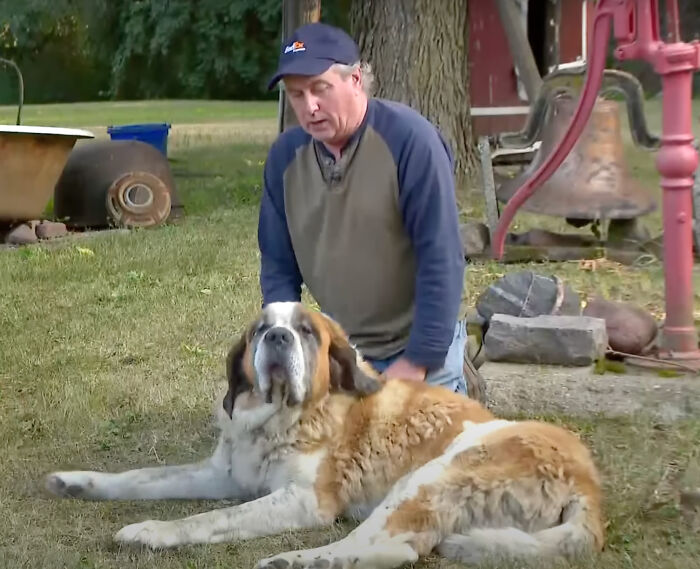
Image credits: WCCO – CBS Minnesota
Adorable Ed was clearly born under a lucky star. Mitch’s party found him just in time to get him to safety. But what if they hadn’t found him?
Owners want the best for their dogs – the best treats, loads of toys and freedom to roam and explore. Unfortunately, letting your dog off the leash can be very dangerous as they can get lost like poor Ed here. They might decide to snack on something dangerous that can result in a stack of medical bills and a long and painful recovery. Keep an eye on your pet to avoid injuries or some malicious person trying to steal your beloved pooch.
Walks with their human are the highlight of any dog’s day and they look forward to it. It’s that one time of the day when they have your undivided attention and love, so try to make the best out of it. Avoid going on your phone or listening to music; instead, try talking to your dog and watch their face light up when you say, ‘hey buddy!’. The more fun activities you do, the stronger the bond you create with your pooch. Look into those eyes and remember that you are everything to them, so make the most of the short time you have together.
People in the comments praised the bachelors for their act of kindness









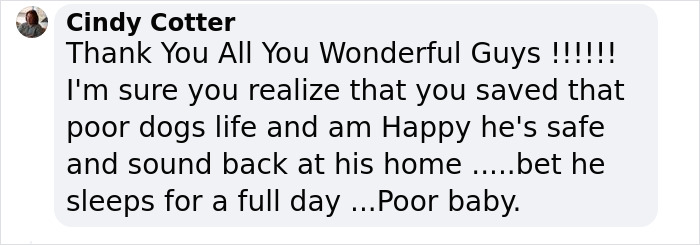




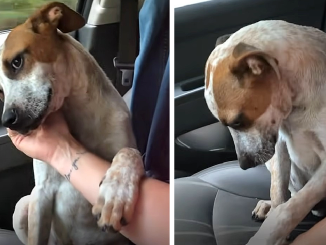
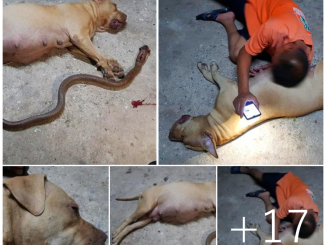
Leave a Reply